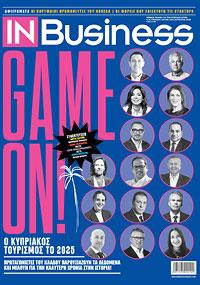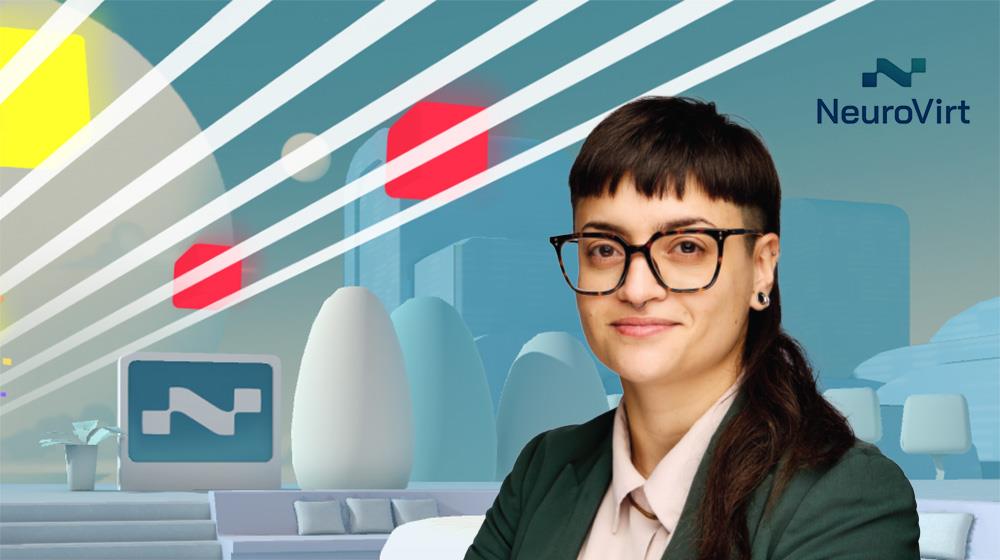Dr Eve Gregoriou, the founder and CEO of NeuroVirt, which has developed an immersive Virtual Reality (VR) platform for gamified rehabilitation, discusses why this is a groundbreaking development for overburdened healthcare systems, clinicians and, more importantly, patients, amid a commercial flurry of enthusiasm for VR in healthcare.
What we do,” Dr Eve Gregoriou explains, “is increase the intensity and accessibility to good-quality rehabilitation.” It is a disheartening truth that healthcare systems across the world lack the human capital to fully rehabilitate patients with long-term disabilities. The ratios in the EU, the UK and the US hover between two and four doctors per thousand patients. Whether sweeping reforms can bridge that gap – or whether their impact is even measurable – remains an open question. What is measurable, however, is the effect of smart, targeted technology. In 2020, at the height of the pandemic, Gregoriou launched NeuroVirt in the UK: an immersive virtual reality platform using games to help tackle stroke rehabilitation.
Leaving academia to fix stroke rehab
Gregoriou shares her generation’s instinct: the goal is not status or money but to fix what’s broken. She quickly gravitated towards more debilitating neurological conditions, such as stroke, that often leave survivors with lasting impairments. As a neuroscientist, she immersed herself in brain stimulation research, using tools like transcranial magnetic stimulation and direct current stimulation, which aim to alter brain activity to enhance motor function and accelerate recovery. But it was during her PhD studies at University College London that the limitations of academia began to gnaw at her. “In academia, you don’t learn about the different care pathways that patients undergo, how hospitals work operationally and the different barriers to bringing technology to patients,” she explains. She found herself boxed into studying a narrow slice of science, using technologies and metrics that don’t always translate into the outside world. Industry, though, forced her to ask different questions – not only is this theoretically interesting but how fast can we get someone moving again? So, she joined Conception X, an intensive nine-month programme for entrepreneurial PhD students in the UK. It would become the launchpad for NeuroVirt.
Some 86 million people globally need stroke rehabilitation
The World Health Organization estimates that 86 million people globally need stroke rehabilitation. Stroke is one of the leading causes of long-term disability, with around 80% of survivors experiencing hemiparesis (upper limb impairment). In the clinical sense, recovery is rarely miraculous; it’s methodical. The more you move, the more you engage with the rehab programme, the more your brain learns to adapt. This remarkable rewiring process is thanks to the brain’s neuroplasticity. The brain reorganises itself, forging new connections and forming habits and memories in response to learning, experience and trauma. Conventional wisdom stresses a six-month post-stroke ‘golden window’ when neuroplasticity is at its peak. However, overstretched healthcare systems provide less of the recommended rehab time during that critical period. In the UK alone, studies have shown that only 12% of stroke survivors obtain complete functional recovery after 6 months. A large European study found that 43.7% of ischemic stroke patients were readmitted within 12 months and 74% within 5 years. A common culprit? Falls and recurrent strokes, often the result of poor adherence to rehab programmes and insufficient care. Making matters worse, unsupervised patients in usual care will often compensate incorrectly, leaning forward instead of properly extending or favouring their stronger side. These shortcuts calcify into bad habits, undermining outcomes and driving readmissions. Worse still, Gregoriou says, hospital discharge criteria (this varies by jurisdiction) are met when patients can move from point A to B. “So, patients can get discharged as early as two days after having a stroke, neglecting the upper limbs,” she says.
Easy to use in clinics and homes alike
Designed to be portable and easy to use in clinics and homes alike, NeuroVirt’s platform – initially addressing upper limbs, it now covers lower limbs too – gives clinicians the ability to log in, prescribe personalised treatment plans and monitor adherence. If a patient misses a threshold or the platform raises a flag, the clinician is notified. Metrics on pain, fatigue and range of motion feed into the plan, allowing for adjustment on the go. For the patient, NeuroVirt’s technology detects and corrects subpar movement, allowing for minimal or no supervision. It also allows them to see the light at the end of a long tunnel. Recovering from a stroke demands everything and that’s on top of depression, which is prevalent in survivors. “You’re suddenly dealing with a completely new version of yourself. There’s a lot to navigate emotionally and not being able to see your progress from day to day can be daunting,” she notes.
Returning power and control to the patient
The company recently launched Neurobot, a virtual guide that walks the patient through each step of their rehab journey. It’s multilingual, including English, Greek, Spanish, Chinese, Dutch and German, with more languages to come. All these touchpoints, Gregoriou argues, return power and control to the patient over their recovery in a meaningful way. They are invested and that’s half the battle. “They can see, ‘oh, my hand opened up 2% more’, even though they can’t really see it on a day-to-day basis,” she says. The metrics also show that patients can do more with less: In usual care, patients complete around 30 upper limb repetitions in an hour, whereas with NeuroVirt, they can reach 400. “And that brings results. We’ve seen significant changes in upper limb functionality under the ARAT (Action Research Arm Test) methodology,” she tells GOLD. Assessments are also more efficient in VR, taking just 30 seconds with higher accuracy and less variability, compared to over 20 minutes in a clinical setting. “This has raised eyebrows among clinicians – they see the value of gamified tech not just being about gamification but also about metrics, assessment, consistent outcomes and efficiencies.”
The market is catching up. In 2020, the global healthcare Augmented Reality/Virtual Reality (AR/VR) market was valued at US$1.5 billion. By 2023, the VR segment alone had reached US$3 billion and forecasts show it could balloon to US$17.2 billion by 2030. In the US, insurance providers are rolling out CPT codes for VR therapeutics. A cost analysis from the VIRTUES trial – a large-scale, randomised European study on VR-based treatment strategies – showed that initial VR setup costs are offset by reducing supervision time and enabling clinicians to treat more patients simultaneously. Patients like it. Investors want it. Clinicians are asking for it.
Why gamification matters in rehabilitation
What makes everything tick is the platform’s gamification element. Games have long been a cornerstone of human culture. In Playing with Reality: How Games Have Shaped our World, neuroscientist Kelly Clancy argues that our brains are drawn to games because they are structured environments filled with uncertainty and feedback. The unpredictability – winning, losing, discovering new strategies – triggers dopamine release, motivating people to keep playing and learning. This same mechanism underpins reinforcement learning in artificial intelligence. “What’s important about gamification is it motivates people to engage in more activity,” Gregoriou says. “It incentivises patients in a controlled environment, where completing a specific movement is required to succeed in the game – and that’s good-quality rehabilitation.” For upper limb rehab, NeuroVirt has created a suite of purpose-built games. In one, patients catch flying insects like butterflies with a net, their path calibrated to stretch the patient’s range of shoulder motion. Another has patients sawing logs and building boats for forward reach exercises. For finger flexion and extension, there’s a rhythm game where users catch boxes in time with music. Grip strength is trained via a farm defence game, where patients shoot bazookas, water guns and spray guns to protect animals. “That one,” Gregoriou adds, “is our most addictive game.” For lower limb therapy, patients can cycle through virtual landscapes like the pyramids of Egypt or over the London Eye. There’s a dancing game and games for patients who can’t yet stand. More importantly, the games are adaptive. If a patient can’t fully open their palm, the game adjusts its expectations. By detecting fatigue and muscle tone increases, the games can also ease off to prevent frustration. That’s how real-world clinical care works, too.
A growing movement toward a decentralised healthcare system
For Gregoriou, the rapid growth of tele-rehabilitation is part of a growing movement toward a decentralised healthcare system. This year alone, NeuroVirt will roll out across 11 NHS clinics. She has now relocated to the US, where the company is striking partnerships with major medical institutions like Mount Sinai and Cedars-Sinai. Cyprus is also on Gregoriou’s radar, as NeuroVirt is on course to obtain the EU’s CE marking as a medical device. “If we have enough interest, that would be a reason to bring it. I can definitely see NeuroVirt being used in Cyprus and, because I’m from Cyprus, I’m passionate about bringing it here,” she says. “Now that innovation is gaining momentum in Cyprus, it feels like the right time to bring home something that Cypriots have created.” It’s worth mentioning that NeuroVirt has received an exceptional 15 grants from organisations like the NHS, the National Institute of Health Research and the Small Business Research Initiative. “We’ve done well with grant funding and that speaks to our timing, our team, our innovation and outcomes,” she notes. Including a couple of fundraising rounds, NeuroVirt has raised some US$5 million so far, eyeing further grant funding to scale and expand the technology’s scope. Co-designed with 500 stakeholders, from patients to experts, the technology now projects valuable data for conditions like cerebral palsy, multiple sclerosis and Parkinson’s disease. “And we are moving to cognitive and pain management,” she says.
Finding the right team to build these experiences wasn’t easy. Gregoriou needed “unicorns”: developers fluent in healthcare, skilled in game design for non-gamers and aligned with her mission. “I feel lucky to have found them,” she says. “And we’re just beginning to see how these technologies can slot into real clinical workflows – that’s where NeuroVirt fits. There are a lot of exciting prospects ahead. Now that this technology has been more accepted and implemented, we’re positioning ourselves as a leader in this space.”
- (This exclusive interview was first published in the May issue of GOLD magazine. Click here to view it)









